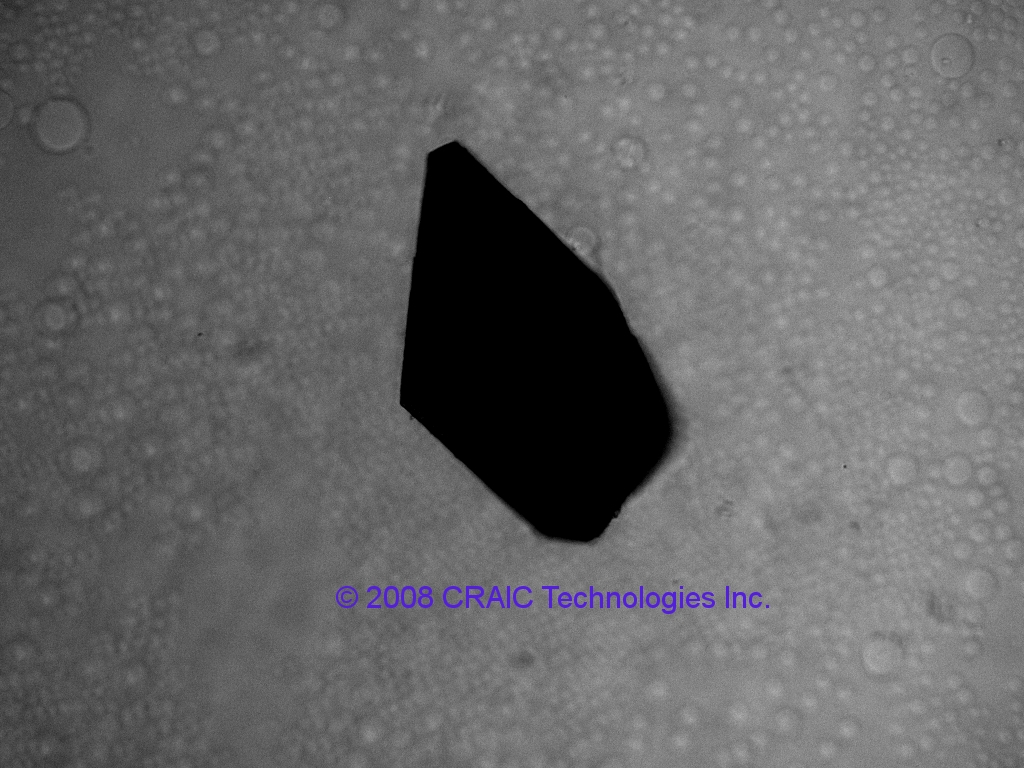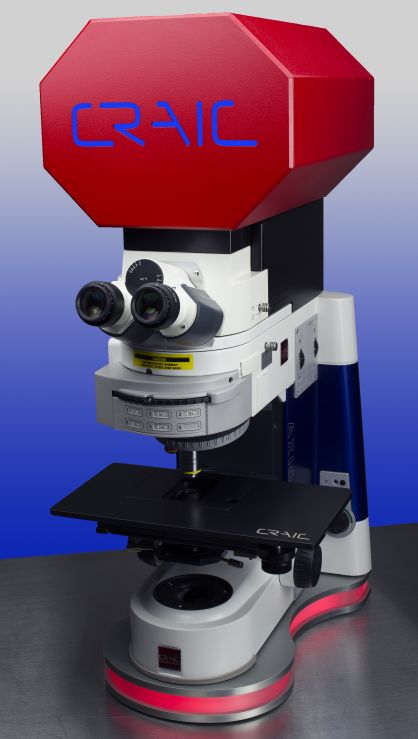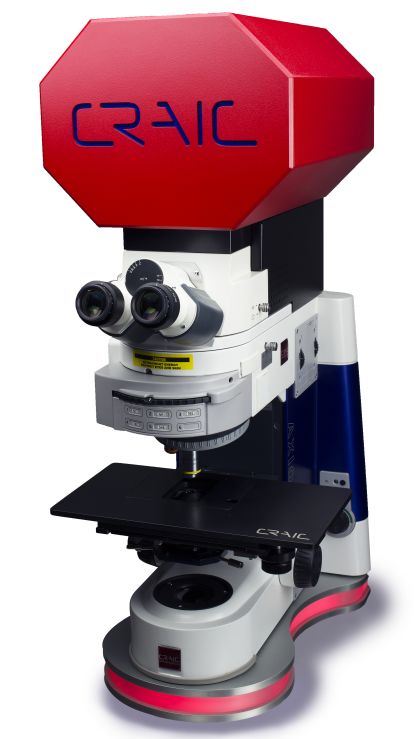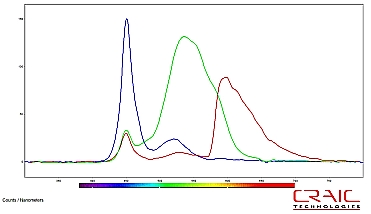Nanophotonic Research Instrumentation
Microspectrophotometers can be used for nanophotonic research.
Nanophotonic Research deals with phenomena in the ultraviolet, visible and near IR region with wavelengths from approximately 300 to 1200 nm. Nanophotonic research deals with studying the properties of light at these scales as well as developing tools and technologies to take advantage of these phenomena. This includes optical bandgap crystals, colloidal metals and more.
CRAIC Technologies offers a number of solutions for nanophotonics research. These include spectrophotometers for microscale analysis, such as the 20/30 PV™, as well as advanced UV-visible-NIR microscopes for imaging nanophotonics samples.
To learn more about the science behind nanophotonics research and analysis, select one of the following links:
Uses of Microspectrophotometers
RNA and RNA Crystals

Ultraviolet absorbance image of a biocrystal in solution
Protein and Protein Crystals
DNA and DNA Crystals
Science of Microspectrophotometers
Ultraviolet Absorption Microscope
Ultraviolet Absorption Microspectrophotometer
Ribonucleic acid (RNA), like DNA, is an essential part of living beings. It is a single long strand of nucleotides that is used in the synthesis of proteins, gene expression, duplication of genetic material, gene regulation and more. As such, there are many types of RNA. For example, the coding of messenger RNA, which is obtained from DNA, determines the amino acid sequence in proteins. Transfer and ribosomal RNA have different functions to that of messenger RNA.
RNA differs from DNA in three major ways even though both are nucleotide strands. Firstly, RNA contains ribose rather than deoxyribose. Secondly, the complementary base to adenine is uracil rather than thymine (as in DNA). And finally, the RNA nucleic acid is a single strand rather than the double strand found in DNA.
RNA crystals are grown so that their three dimensional structures may be studied. This is useful for genetic research, studies of protein binding, drug development research and much more.
Optical Properties
Since RNA is composed of the same or similar nucleotides as DNA, it's optical properties are nearly identical. The nucleotides in RNA absorb ultraviolet light, generally from 250 to 270 nm and fluorescence is not a viable analytical technique. Therefore, most RNA crystals are analyzed by their UV absorption at 260 nm. UV microscopes and UV microspectro-photometers are used to analyze individual RNA crystals both in solution and after being extracted. Microspectrophotometers can even be used to determine the concentration of RNA within the crystal and the RNA crystal purity. As protein often contaminates RNA samples, RNA purity is measured by comparing the absorption intensity at 260 nm versus that at 280 nm. A ratio of about 2.0 is considered "pure" for RNA. Lower ratios indicate the presence of protein.
DNA Crystal

Ultraviolet absorbance image of a biocrystal in solution
Science of Microspectrophotometers
Ultraviolet Absorbance Microscope
Ultraviolet Absorbance Microspectrophotometer
Deoxyribonucleic acid (DNA) is an essential part of living beings. It is a long chain of nucleotides that contains genetic blueprints used in the growth and functioning of known lifeforms and some viruses. Structurally, it consists of two long chains of nucleotides that form the two nucleic acids. These nucleic acids then intertwine with one another to form the famed double helix.
DNA crystals are grown so that their three dimensional structures may be studied by x-ray diffraction. An even more exciting application is using DNA crystals and the growth of DNA crystals for computing. This is just one of the most promising applications of nanotechnology in which DNA is a building block for well defined nanostructures.
Optical Properties
The nucleotides in DNA absorb ultraviolet light, generally from 250 to 270 nm. Fluorescence is not a viable analytical technique. Therefore, most DNA crystals are analyzed by their UV absorption at 260 nm. UV microscopes and UV microspectro-photometers are used to analyze individual DNA crystals both in solution and after being extracted. Microspectrophotometers can even be used to determine the concentration of DNA within the crystal and the DNA crystal purity. As protein often contaminates DNA samples, DNA purity is measured by comparing the absorbance intensity at 260 nm versus that at 280 nm. A ratio of about 1.8 is considered "pure" for DNA. Lower ratios indicate the presence of protein.
Cytophotometry
Cytophotometry is the UV-vsibile-NIR spectral analysis of cellular components.
Cytophotometry is the UV-visible-NIR spectral analysis of cellular components. In other words, cytophotometry utilizes a microspectrophotometer of which there are two basic types: the fully integrated microspectrophotometer that has been built and optimized for microspectroscopy and the spectrophotometer unit designed to attach to an open photoport of a biological microscope. Depending upon the configuration, both are capable of measuring the spectra of microscopic samples by transmission, absorption, reflectance, fluorescence, emission and polarization microspectroscopy. With special software, both are capable of thin film thickness measurements and colorimetry as well.
A CRAIC Technologies™ microspectrophotometer is a purpose-built system that allows you to analyze UV-visible-NIR range microspectra™ non-destructively and with no sample contact. Capable of analyzing even sub-micron areas, they are also capable of high resolution digital imaging. Designed for ease-of-use, they are durable instruments designed for microscale spectroscopy.
To learn more about cytophotometry and microspectrophotometers, select one of the following links:
What is a Microspectrophotometer?
Science of Microspectrophotometry
Uses of Microspectrophotometers
Cytophotometer
The Cytophotometer measures the UV-vsibile-NIR spectra of sub-cellular components.
The Cytophotometer is designed to measure UV-visible-NIR spectra of cellular components. In other words, the cytophotometer is a microspectrophotometer of which there are two basic types: the fully integrated microspectrophotometer that has been built and optimized for microspectroscopy and the spectrophotometer unit designed to attach to an open photoport of a biologicalal microscope. Depending upon the configuration, both are capable of measuring the spectra of microscopic samples by transmission, absorption, reflectance, fluorescence, emission and polarization microspectroscopy. With special software, both are capable of thin film thickness measurements and colorimetry as well.
A CRAIC Technologies™ microspectrophotometer is a purpose-built system that allows you to analyze UV-visible-NIR range microspectra™ non-destructively and with no sample contact. Capable of analyzing even sub-micron areas, they are also capable of high resolution digital imaging. Designed for ease-of-use, they are durable instruments designed for microscale spectroscopy.
To learn more about microspectrophotometry and microspectrophotometers, select one of the following links:
What is a Microspectrophotometer?
Science of Microspectrophotometry
Uses of Microspectrophotometers




